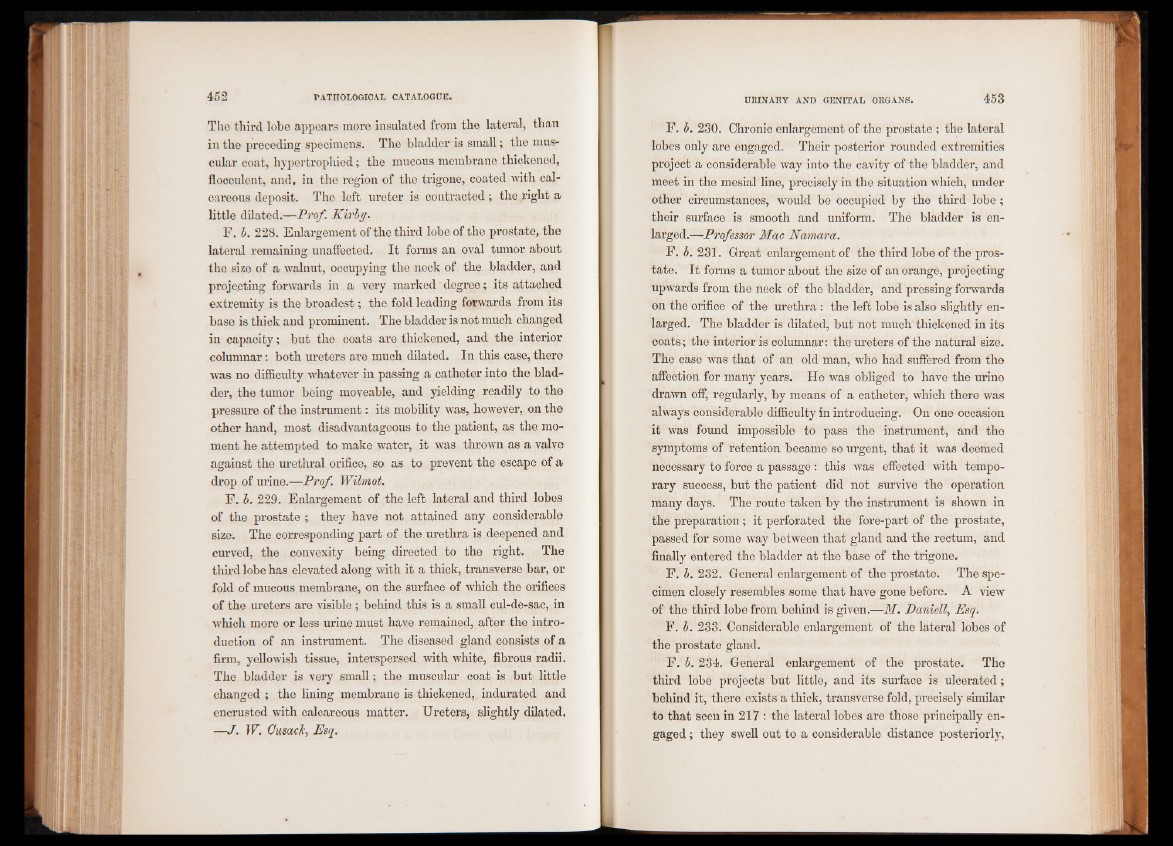
The third lobe appears more insulated from the lateral, than
in the preceding specimens. The bladder is small; the muscular
coat, hypertrophied; the mucous membrane thickened,
flocculent, and, in the region of the trigone, coated with calcareous
deposit. The left ureter is contracted ; the right a
little dilated.—Prof. Kirby.
F. b. 228. Enlargement of the third lobe of the prostate, the
lateral remaining unaffected. It forms an oval tumor about
the size of a walnut, occupying the neck of the bladder, and
projecting forwards in a very marked' degree; its attached
extremity is the broadest; the fold leading forwards from its
base is thick and prominent. The bladder is not much changed
in capacity; but the coats are thickened, and the interior
columnar: both ureters are much dilated. In this case, there
was no difficulty whatever in passing a catheter into the bladder,
the tumor being moveable, and yielding readily to the
pressure of the instrument: its mobility was, however, on the
other hand, most disadvantageous to the patient, as the moment
he attempted to make water, it was thrown as a valve
against the urethral orifice, so as to prevent the escape of a
drop of urine.—Prof. Wilmot.
F. b. 229. Enlargement of the left lateral and third lobes
of the prostate ; they have not attained any considerable
size. The corresponding part of the urethra is deepened and
curved, the convexity being directed to the right. The
third lobe has elevated along with it a thick, transverse bar, or
fold of mucous membrane, on the surface of which the orifices
of the ureters are visible ; behind this is a small cul-de-sac, in
which more or less urine must have remained, after the introduction
of an instrument. The diseased gland consists of a
firm, yellowish tissue, interspersed with white, fibrous radii.
The bladder is very small; the muscular coat is but little
changed ; the lining membrane is thickened, indurated and
encrusted with calcareous matter. Ureters, slightly dilated.
—J. W. Cusack, Esq.
F. b. 230. Chronic enlargement of the prostate ; the lateral
lobes only are engaged. Their posterior rounded extremities
project a considerable way into the cavity of the bladder, and
meet in the mesial line, precisely in the situation which, under
other circumstances, would be occupied by the third lobe;
their surface is smooth and uniform. The bladder is enlarged.—
Professor Mac Namara.
F. b. 231. Great enlargement of the third lobe of the prostate.
It forms a tumor about the size of an orange, projecting
upwards from the neck of the bladder, and pressing forwards
on the orifice of the urethra : the left lobe is also slightly enlarged.
The bladder is dilated, but not much thickened in its
coats; the interior is columnar: the ureters of the natural size.
The case was that of an old man, who had suffered from the
affection for many years. He was obliged to have the urine
drawn off, regularly, by means of a catheter, which there was
always considerable difficulty in introducing. On one occasion
it was found impossible to pass the instrument, and the
symptoms of retention became so urgent, that it was deemed
necessary to force a passage: this was effected with temporary
success, but the patient did not survive the operation
many days. The route taken by the instrument is shown in
the preparation; it perforated the fore-part of the prostate,
passed for some way between that gland and the rectum, and
finally entered the bladder at the base of the trigone.
F. b. 232. General enlargement of the prostate. The specimen
closely resembles some that have gone before. A view
of the third lobe from behind is given.—M. Daniell, Esq.
F. b. 233. Considerable enlargement of the lateral lobes of
the prostate gland.
F. b. 234. General enlargement of the prostate. The
third lobe projects but little, and its surface is ulcerated;
behind it, there exists a thick, transverse fold, precisely similar
to that seen in 217 : the lateral lobes are those principally engaged
; they swell out to a considerable distance posteriorly,